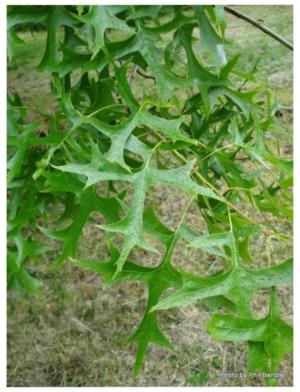Hybrid Oak
(Quercus vaga)

Description
Quercus vaga is a species of oak tree that belongs to the Fagaceae family, which is found in Southeast Asia. In this article, we will explore the characteristics of Quercus vaga and its significance in the natural world. Taxonomy Quercus vaga was first described by Carl Ludwig Blume in 1850 in his book "Catalogus van eenige der merkwaardigste zoo in-als uitlandsche boomgewassen." The scientific name "Quercus vaga" derives from the Latin words "quercus," meaning "oak," and "vaga," meaning "wandering" or "vagrant." This species is commonly known as the Himalayan oak or the wandering oak. Characteristics Quercus vaga is a deciduous tree that can grow up to 30 meters in height. Its leaves are oblong-shaped, with a length of 10-20 centimeters and a width of 4-9 centimeters. The leaves have serrated margins, a smooth upper surface, and a slightly hairy lower surface. The leaves turn reddish-brown in autumn before falling off. The bark of Quercus vaga is dark gray and deeply furrowed, giving the tree a rugged appearance. The tree produces acorns that are about 2-3 centimeters long and are enclosed in a cup-like structure called a "cupule." The cupule has a warty texture and covers about one-third of the acorn. Distribution and Habitat Quercus vaga is native to Southeast Asia, specifically in the Himalayan region. It is commonly found in Bhutan, China, India, Myanmar, Nepal, and Pakistan. The tree grows in a wide range of habitats, including open forests, mountain slopes, and riverbanks. Ecological Significance Quercus vaga is an important species in its natural habitat as it provides food and shelter for various wildlife species. The tree's acorns are a food source for many mammals, such as squirrels, deer, and wild boar. The leaves and bark of the tree are also used as food by some insects and caterpillars. In addition, the tree's dense canopy provides shade and shelter for birds and other small animals. Apart from its ecological significance, Quercus vaga also has cultural and economic value in some regions. In some communities, the tree's bark is used for tanning leather and making dyes, while the wood is used for furniture and construction. The tree is also considered sacred in some cultures, and its acorns are used in traditional medicine. Conservation Status Quercus vaga is not currently listed as an endangered species. However, like many other tree species, it is threatened by deforestation, habitat loss, and climate change. The tree's slow growth and long lifespan make it vulnerable to these threats, and conservation efforts are necessary to ensure its survival. Conclusion Quercus vaga is a fascinating species of oak tree that plays a crucial role in its natural habitat. Its unique characteristics, ecological significance, and cultural and economic value make it an important species to conserve. By understanding the importance of Quercus vaga, we can work towards preserving it for future generations to appreciate and benefit from.
Taxonomic tree:







